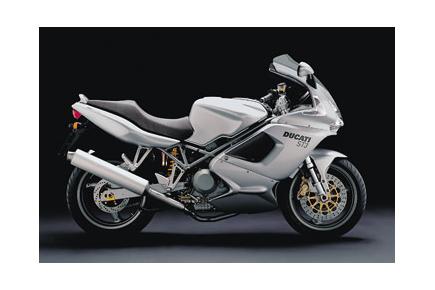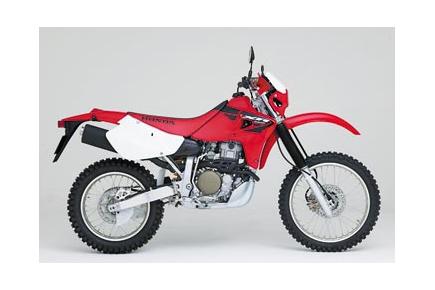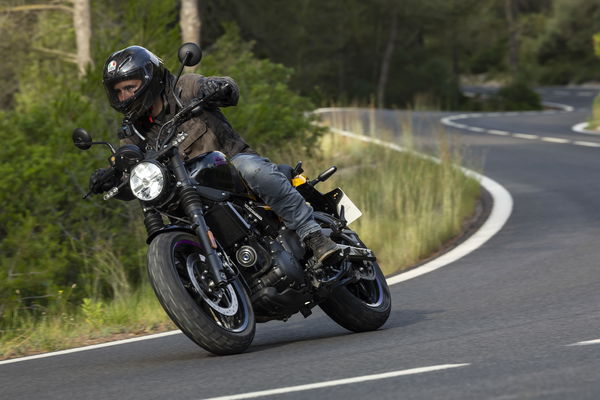ST3 (2003 - 2008) review
The Ducati now looks much more modern, costs less and is close on handling to the class ruler, the VFR

With the launch of the ST range in 1997, Ducati launched a very good sports touring bike that has done a lot to give the Ducati name some touring credibility. For 2004, Ducati has killed off the dead duck ST2 and replaced it with the ST3, using a new motor with a three valve head, instead of the conventional four.
As the theory goes a two valve head creates better torque low-down than a four valve but at the sacrifice of mid-range and top end power. The four valve can get ride of the burnt gases faster at high revs because there are two holes instead of one to get them out of the head and into the exhaust. Honda tried to get around this problem on the VFR800 by fitting the VTEC system which makes the head run on two valves, giving low down torque, until a pre-determined point where two other valves come into play, making it a four valve head and giving it good top end power.
Rather than take the costly, and very complicated, route of creating a similar system Ducati has instead gone the route of a three valve head, like the old Honda Super Dreams of yesteryear. Each of the ST3’s heads has two intake valves, each 34mm diameter, and one big exhaust valve of 40mm. According to the technical people this solution gives the same low-down torque as a four valve motor as well as a very comparable mid-range in both power and torque. Which is where you want it with a sports tourer. So what’s the catch? Well the three valve head won’t rev as high as the four valve and top end is sacrificed, which shouldn’t be a huge problem to those who want to tour in a relaxed fashion.
To go with the new engine, Ducati has also given the ST3 a new look and added a few neat touches customers have been demanding.
It’s a small but significant point that the ST3 now comes with adjustable brake and clutch levers. It’s the kind of thing that you expect a bike to have but until now the whole ST range had screw adjusters that were glued into position and impossible to adjust while you were on the move.
The dash is now the same as the Multistrada and comes with a fuel gauge, fuel consumption meter, average speed and distance left on the fuel in the tank – again small things but necessary on a decent sports tourer. The bars can now be raised or lowered by 20mm simply by loosening two bolts, the seat is thicker and made of softer foam, the fairing is wider and taller and the headlight position can be electronically adjusted. All neat touches that improve on an already good package. And this really sums up what the ST3 is. Basically Ducati has refined the ST2, given it more grunt and kept it at a similar price.
The new motor is very impressive to use. It feels easily as strong at the old 916-engined ST4 and on a top gear roll-on with the ST4S, (which uses a larger capacity 996cc engine) it easily held its own through the mid-range and even crept ahead slightly until the top-end of the ST4 kicked in. A lot of this can be put down to gearing as Ducati has down-geared the ST3 so top speed will be down but realistically you seldom find yourself feeling the need to go much faster than the 125mph the ST3 easily powers its way up to.
The fuel injection through the range is pretty much spot on although it can be a bit harsh coming on and off a closed throttle and below 3000rpm the engine objects to being at such low revs by shuddering and shaking in typical V-twin fashion. But when you’re on sweeping corners the low-down grunt offered by the new engine is excellent, in fact I found it better and easier to ride through corners which you go in slow (usually because of a huge drop off a cliff on one side should you be on our Spanish test route) and then drive through than the ST4S with its more conventional motor.
Although chassis geometry and suspension is basically identical to the ST2 it replaces, the ST3 handles better. According to some of the journalists who were on the launch of the ST2 the first time around the vague feeling through corners that the old bike had was due to it being too low at the rear end. Basically Ducati had to set it low compromising cornering for high-speed stability. The new fairing design of the ST3 has aerodynamics more in mind and has been designed to improve the high-speed stability without having to compromise rear ride height. You have to remember it is a sports tourer so on standard suspension settings it can feel a little soft but the ST3 can be hustled around corners with a fair degree of enthusiasm, and all in comfort.
The Walter the Softy redesigned seat is more than padded enough to stop even the most tender arsed biker from feeling any discomfort and the bars in their highest position, which is 20mm higher than the previous ST bikes, can be adjusted to suit your particular build. The fairing does a good job of protecting you with a lip on the top of the screen deflecting a decent amount of air over your head. And check this out, the ST3’s mirrors actually show what’s behind – that has to be a first for a Ducati!
I was really impressed by the ST3. It is cheaper than the VFR and although the Honda has a slightly sportier edge the ST3 isn’t far behind. When compared to the ST4S, which costs £1200 more, I would choose the ST3 every time and spend the saving uprating its suspension because that’s the only thing it lacks compared to its more expensive brother. The doubters will still bring up reliability as an issue but Ducati really has done a lot of work to try and shed this image and improve its bikes. The big question of course is will it beat a VFR, the sports tourer benchmark? I’m not 100 per cent. It will be close and I think the VFR may still edge it, but only just.
With the launch of the ST range in 1997, Ducati launched a very good sports touring bike that has done a lot to give the Ducati name some touring credibility. For 2004, Ducati has killed off the dead duck ST2 and replaced it with the ST3, using a new motor with a three valve head, instead of the conventional four.
As the theory goes a two valve head creates better torque low-down than a four valve but at the sacrifice of mid-range and top end power. The four valve can get ride of the burnt gases faster at high revs because there are two holes instead of one to get them out of the head and into the exhaust. Honda tried to get around this problem on the VFR800 by fitting the VTEC system which makes the head run on two valves, giving low down torque, until a pre-determined point where two other valves come into play, making it a four valve head and giving it good top end power.
Rather than take the costly, and very complicated, route of creating a similar system Ducati has instead gone the route of a three valve head, like the old Honda Super Dreams of yesteryear. Each of the ST3’s heads has two intake valves, each 34mm diameter, and one big exhaust valve of 40mm. According to the technical people this solution gives the same low-down torque as a four valve motor as well as a very comparable mid-range in both power and torque. Which is where you want it with a sports tourer. So what’s the catch? Well the three valve head won’t rev as high as the four valve and top end is sacrificed, which shouldn’t be a huge problem to those who want to tour in a relaxed fashion.
To go with the new engine, Ducati has also given the ST3 a new look and added a few neat touches customers have been demanding.
It’s a small but significant point that the ST3 now comes with adjustable brake and clutch levers. It’s the kind of thing that you expect a bike to have but until now the whole ST range had screw adjusters that were glued into position and impossible to adjust while you were on the move.
The dash is now the same as the Multistrada and comes with a fuel gauge, fuel consumption meter, average speed and distance left on the fuel in the tank – again small things but necessary on a decent sports tourer. The bars can now be raised or lowered by 20mm simply by loosening two bolts, the seat is thicker and made of softer foam, the fairing is wider and taller and the headlight position can be electronically adjusted. All neat touches that improve on an already good package. And this really sums up what the ST3 is. Basically Ducati has refined the ST2, given it more grunt and kept it at a similar price.
The new motor is very impressive to use. It feels easily as strong at the old 916-engined ST4 and on a top gear roll-on with the ST4S, (which uses a larger capacity 996cc engine) it easily held its own through the mid-range and even crept ahead slightly until the top-end of the ST4 kicked in. A lot of this can be put down to gearing as Ducati has down-geared the ST3 so top speed will be down but realistically you seldom find yourself feeling the need to go much faster than the 125mph the ST3 easily powers its way up to.
The fuel injection through the range is pretty much spot on although it can be a bit harsh coming on and off a closed throttle and below 3000rpm the engine objects to being at such low revs by shuddering and shaking in typical V-twin fashion. But when you’re on sweeping corners the low-down grunt offered by the new engine is excellent, in fact I found it better and easier to ride through corners which you go in slow (usually because of a huge drop off a cliff on one side should you be on our Spanish test route) and then drive through than the ST4S with its more conventional motor.
Although chassis geometry and suspension is basically identical to the ST2 it replaces, the ST3 handles better. According to some of the journalists who were on the launch of the ST2 the first time around the vague feeling through corners that the old bike had was due to it being too low at the rear end. Basically Ducati had to set it low compromising cornering for high-speed stability. The new fairing design of the ST3 has aerodynamics more in mind and has been designed to improve the high-speed stability without having to compromise rear ride height. You have to remember it is a sports tourer so on standard suspension settings it can feel a little soft but the ST3 can be hustled around corners with a fair degree of enthusiasm, and all in comfort.
The Walter the Softy redesigned seat is more than padded enough to stop even the most tender arsed biker from feeling any discomfort and the bars in their highest position, which is 20mm higher than the previous ST bikes, can be adjusted to suit your particular build. The fairing does a good job of protecting you with a lip on the top of the screen deflecting a decent amount of air over your head. And check this out, the ST3’s mirrors actually show what’s behind – that has to be a first for a Ducati!
I was really impressed by the ST3. It is cheaper than the VFR and although the Honda has a slightly sportier edge the ST3 isn’t far behind. When compared to the ST4S, which costs £1200 more, I would choose the ST3 every time and spend the saving uprating its suspension because that’s the only thing it lacks compared to its more expensive brother. The doubters will still bring up reliability as an issue but Ducati really has done a lot of work to try and shed this image and improve its bikes. The big question of course is will it beat a VFR, the sports tourer benchmark? I’m not 100 per cent. It will be close and I think the VFR may still edge it, but only just.
| Seats | 0 |
| Suspension Front | Showa 43 mm adjustable preload upside-down fork |
| Suspension Rear | Progressive linkage with fully adjustable Sachs monoshock |
| Wheels Front | 3.50x17 |
| Wheels Rear | 5.50x17 |
| Wheels Made Of | 3-spoke light alloy |
| Tyres Front | 120/70 ZR 17 |
| Tyres Rear | 180/55 ZR 17 |
| Brakes Front | 2 x 320 mm semi-floating discs, 4-piston caliper |
| Brakes Rear | 245 mm disc, 2-piston caliper |
| Chassis | Tubular steel trellis |
| Cubic Capacity (cc) | 992 |
| Valves | 6 |
| Max Power (bhp) | 102 |
| Max Power Peak (rpm) | 8750 |
| Torque (ft/lb) | 69 |
| Torque Peak (rpm) | 7250 |
| Bore (mm) | 94 |
| Stroke (mm) | 71.5 |
| Valve Gear | DOHC |
| Compression Ratio | 11.3 |
| Valves Per Cylinder | 3 |
| Cooling | Liquid cooled |
| Fuel Delivery | Electronic |
| Stroke Type | Four Stroke |
| Drive | Chain |
| Top Speed | 146.2 |
| Max Power | 100 |
| Max Power Revs | 8600 |
| Max Torque | 65.8 |
| Max Torque Revs | 7100 |
| Standing Quarter Mile - Terminal Speed MPH | 112.05 |
| Standing Quarter Mile - Time | 11.59 |











